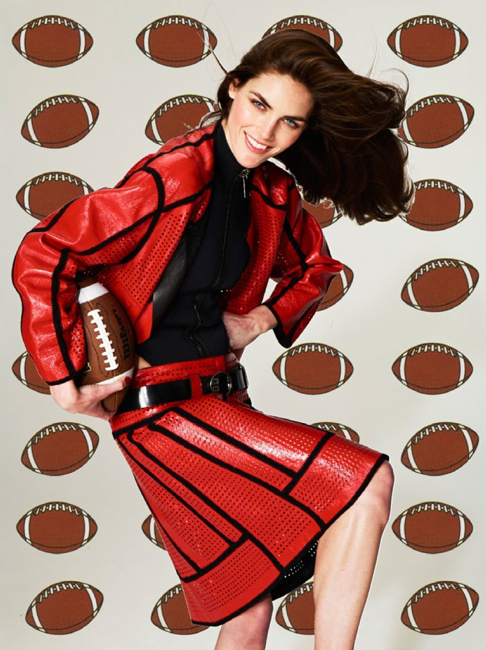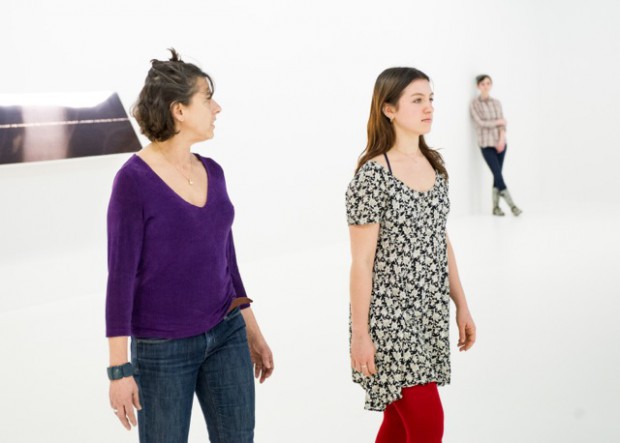Roe Ethridge: Sacrifice Your Body at Andrew Kreps (537 West 22nd Street, New York, NY)
Runs through March 29, 2014
What’s on view: Sleek-looking photographs of models, food, and footballs, all with a surrealist bent
Corinna: Roe Ethridge’s works are deceitful. At times, some of his dozen or so photographs look like high-end fashion adverts; that’s an obvious reading given that there’s close-ups of Chanel clothing labels and supermodel Gisele Bundchen. Seen on their own, these photos give off a feeling of empty glamour. But those are just a few of the photos, and after spending some time in the gallery, some weirdness emerges, even in some of the more straightforward photographs; some objects seem to hover, and a slimy sheen seems to cover all things. It’s an exhibition that requires some slowness to get there, though.
Whitney: Yeah, the mix of things like slimy fish and corpse-colored ramen made the luxury body fetishism in the fashion photos seem kind of gross. Did you think that was a good thing? Or an effective thing? It’s a smart trick, but I didn’t take much away from it beyond that because the images are so general. What’s he trying to do here?
Corinna: Are they really that general? I hadn’t thought of that before, but stock photography does seem to influence Ethridge’s work. He’s got a fine method—or trick, as you say—going on and it makes for some good-looking photography. But beyond showing an underlying similarity between bodies, fish, and food, I can’t say I think there’s much at stake.
Paddy: I think this work is entirely about making different narrative and visual threads. The show is too small—you can buy Ethridge’s book at the gallery (a pricey $60 bucks for a soft cover!) with the complete images and I think that helps understand the show. You see several shots of that empty jam jar—one has it being pushed off the porch by a football. There are also many more shots of the murky lake, which is actually the spot of a crashed car.
I don’t think these narratives are supposed to be joined so we can take home one message: My feeling is that brands and objects have photographic narratives to them, and Ethridge is adept at teasing these out.
Gerard & Kelly: Timelining at The Kitchen (512 West 19th Street, New York, NY)
Runs through April 19, 2014
What’s on view: Two actors, one middle-aged and one in their 20s, would walk together around the room in circles and take turns reciting a series of memories that seemed to go backward in time. They’d use the phrase “in front of” to stack the lines, such as: “The woman with the floral pants walked in the room, in front of…Feeling sick with my head on your knee, in front of…throwing up this morning, in front of….”
The room also included partially-erased wall text and a gallery wall leftover from previous Kitchen exhibitions of Boru O’Brien O’Connell and Luke Stettner and a series of sculptures by Gerard & Kelly.
Corinna: When I walked into the gallery, the first thing I heard was booming “actor voice.” I don’t know if that’s an actual term, but you know the type of stylized speech that sounds a little too overly rehearsed, a little too focused on projection rather than emotion. So I wasn’t too turned on by that type of acting; it seems to contrast too much with the type of personal memories the actors were supposed to be revealing to each other as they walked around in circles.
Other than my quibble over “actor voice,” I mostly liked how the performance treated memory. Memory is supposed to be something absolutely personal and particular, right? But no, the memories these actors ended up talking about were really general, and often focused on public events. Princess Diana’s death, losing one’s virginity, and moving to New York were all fair game for these actors to talk about. Now that’s just a sad existential fact, that our memories could be swapped with others.
But that leads me to my one gripe with this performance’s logic of how memory functions, as a series of events made relatable by sentences. Why weren’t there any exclamations of sensations (“red!”) or emotions (“sad!”)? Memory is faulty and fragmented; it’s just not as clean as it’s presented in Gerard & Kelly’s performance.
Whitney: Well, I didn’t have such a problem with the way memories were listed off as generic actions, since I just thought it was one lens to look at life. As each person recited periods of their life, going back in time, you piece together a very broad picture of several years.
Like you said, it made different experiences seem like existential copies of each other. For example, when I went, the actors seemed to be mother and daughter (based on recurring names like “your father”). The younger woman was wondering whether she should feel okay about being an artist, or become a community organizer. The older woman said she spent the eighties waitressing at a macaroni restaurant and wondering what the fuck to do with her life. I felt like the list of life choices was an apt way to sum up that feeling of life passing by.
Also I was fortunately spared the booming “actor voice” when I went, probably because I got two women. But that’s a bummer.
Corinna: Oh, sounds like your session was better than ours. We went when there was one man, possibly in his 20s, and a slightly older woman. It sounds like the actors you saw were better at being less-than generic, although, to be honest, it was the generic aspect of memory that got me interested in the performance in the first place. I just hoped it’d move away from that and get a bit more complex.
Anyway, I should probably mention that this performance was still a lot better than most of the other stuff we saw in Chelsea that day.
Whitney: Should we talk about the sculptures?
Corinna: No.
Doug Wheeler at David Zwirner (537 West 20th Street, New York, NY)
Runs through April 5, 2014
What’s on view: A walk-in installation where the light changes subtly like with James Turrell
Corinna: I hate this show more than I should.
Whitney: Why?
Corinna: Looking at lights change is nice and all, but that’s all it is—just nice. I hate that you have to put on white booties in order to have a more precious experience. But that’s not real; gimme just a little bit of dirt, plz. I hate that this is just James Turrell, but you can actually get up to the light source and see some of the lights turn on and off.
Whitney: I haven’t seen the Wheeler show, but having just seen Turrell at LACMA, the Turrell finale room looks almost identical to Wheeler’s show two years ago at Zwirner. Either somebody’s getting ripped off, or, like Paddy mentioned in the office, maybe illusionistic walls are the logical conclusion of high-impact colored light.
Paddy: Ultimately I have just as many problems with Turrell as I do with Wheeler. It feels nice to be bathed in such manicured light, but in both cases, you feel like somehow the museum or the gallery space is limiting for these artists. They feel like art playhouses, rather than the transformative experiences one would seek from them. For that, I think they need to build their own spaces. I’m more than happy to travel to one or two of them, if it means avoiding the pretension of the gallery waiting lists. There’s something that just feels wrong about having to wait to go into what is essentially a showroom.






Comments on this entry are closed.